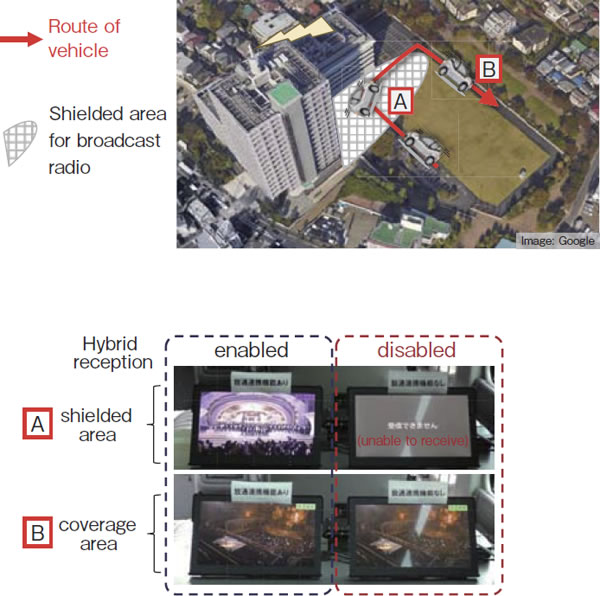Research Area
1.7 Media transport technologies
We are conducting R&D on the use of MPEG Media Transport (MMT) technology as a multiplexing transmission method for next-generation terrestrial broadcasting. We are also conducting research on IP multicast delivery technology using MMT, in which we demonstrated the IP delivery of 4K/8K live content and presented a new viewing experience using inter-terminal synchronization technology.
■Multiplexing transmission method for next-generation terrestrial broadcasting
Aiming for next-generation terrestrial broadcasting, we researched a multiplexing scheme for IP packets that conforms to the channel coding system for terrestrial broadcasting and an IP transmission system used over studio to transmitter links (STLs) and transmitter to transmitter links (TTLs) to enable a single-frequency network (SFN). We compiled our findings into specifications and conducted verifications with a prototype remux(1). More specifically, we performed experiments at the Hitoyoshi and Mizukami experimental stations in Kumamoto Prefecture on transmitting output signals from the remux to multiple modulators over commercial IP networks. The results demonstrated that an IP transmission-based SFN can be built by using signaling information in the signals for synchronization control. To improve the quality of mobile services in next-generation terrestrial broadcasting, we proposed a broadcast signal complementary system that allows continuous program viewing even when broadcast waves are interrupted during travel by seamlessly switching to the reception by mobile communications. The results of field experiments (Figure 1-9) demonstrated the feasibility of the system(2)(3).
Part of this research was conducted as a government-commissioned project from the Ministry of Internal Affairs and Communications titled “Research and Development for Advanced Digital Terrestrial Television Broadcasting System.”

Figure 1-9. Field experiment using an complementary system
■MMT-based IP multicast delivery technology
To promote 8K SHV broadcasting, we verified MMT-based IP multicast delivery technology that could be used for the IP retransmission of broadcasting in closed networks of cable TV stations and other service providers and for the IP delivery of the relevant content linked with broadcasting. We conducted a delivery experiment using live content from the ISU Grand Prix of Figure Skating 2017/2018, NHK Trophy, and demonstrated that 4K/8K content can be delivered to multiple content delivery service providers simultaneously with low latency. As an example of the application of a high-accuracy synchronization scheme using an absolute time stamp, which is a feature of MMT, we developed an inter-terminal synchronization technology that allows multiple content delivered by IP multicast distribution to be displayed in synchronization without delay by adjusting the timing to display video at the same time with clock synchronization among multiple reception terminals. We exhibited interactive content, “Domo’s Slapstick Race,” using this technology at the NHK STRL Open House 2017, CEATEC JAPAN 2017 and NHK Science Stadium 2017, demonstrating the feasibility of a new viewing experience(4).
| [References] | |
| (1) | S. Aoki et al.: “A Study on IP Multiplexing Scheme in Next-generation Terrestrial Broadcasting System,” ITE Annual Convention, 14C-1 (2017) (in Japanese) |
| (2) | Y. Kawamura et al.: “Field Experiment of Hybrid Video Delivery Using Next-Generation Terrestrial Broadcasting and a Cellular Network,” IEEE International Conference on Consumer Electronics 2018, pp.173-174 (2018) |
| (3) | Y. Kawamura et al.: “An Implementation of a Cooperative Broadcast and Cellular Network System for Mobile Reception of Next-Generation Terrestrial Broadcasting,” ITE Annual Convention, 14C-4 (2017) (in Japanese) |
| (4) | Y. Kawamura: “Inter-Terminal Synchronization Technology Using MMT,” Cable New Era, vol.4, no.7, p.47 (2017) (in Japanese) |